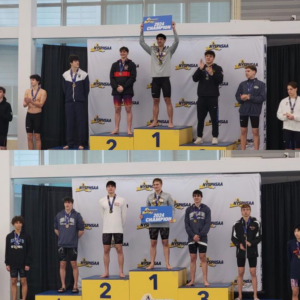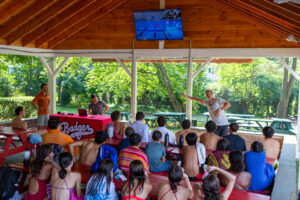A note from Badger Parent Advocate, Michael Conaton:
Happy New Year – The start of the New Year is a good time to review the landscape of the swimming world we all enjoy. I’ll do my best to answer some questions recently submitted and describe some of the swimming organizations I am familiar with. I don’t know if I’ll be 100% accurate with the following but hopefully I’m directionally correct.
Best I can summarize, the competitive swimming world can be generally divided into international, national, local and school related “leagues”. Competition is promoted amongst geographies, like-organizations, and relative skills, including of course, the best of the best. The seasons for these leagues or affiliations can possibly overlap and actually cause conflict for the swimmer regarding allegiances and priorities. (Maybe we’ll address that as a topic later but not the point of this letter). Following are some examples that come to mind and commentary for what it’s worth:
School Swimming
Obviously high schools and colleges sponsor competitive swimming. In New York, our family learned of the interesting concept of the state high school “federation” – the inclusion of both the public and Catholic schools in a single championship. At its heart, I think a great thing to get all the kids in the same meet together to push each other to go faster. In NY, the girls’ season is in the Fall and boys’ in the Winter (varies per state). Most school teams hold seasonal practices, especially if they are lucky enough to have a pool. Some schools do not have pools…or teams for that matter. It can be possible for the kids to have a high school swimming experience by “affiliating” with another high school team. Kip is familiar with how this works if you have questions. You may ultimately even have multiple schools get together for a single combined team. I applaud Kip and the area schools and their administrations for providing this for their kids. High school swimming can be an amazing experience and an activity providing an essential sense of identity and comradery at an important time in a kid’s development. We have found Badger to be very accommodating of the kids who want to compete in high school meets and some practices. Where the kids train (either at their club or the school) can be a very tricky subject. Badger’s affiliations with New Rochelle, Bronxville and Fordham Prep high schools (that I’m aware of) results in a great appreciation for high school swimming (which can conflict with Badger) and is an incredible advantage on many different fronts.
College Swimming I am learning is another world today. I won’t spend a lot of time on it from a Badger parent’s perspective as obviously the kids are away and training with another coach. Again, another age old issue is where the kids train when they come home from school. Holiday training is an easier decision as the old club is close to home. As kids, we used to love it when the college kids came home and trained with us over the holidays and in the summer. Perhaps another topic someday…
Local Swimming
We’re probably all familiar with community summer swim and country clubs that offer limited seasonal summer training, local dual meets and end of summer championships. Great experience for our kids – these summers represented some of the fun aspects of swimming – being with friends, learning team comradery, looking out for the little kids…etc. And yes some great head to head racing. It gets tough as the kids get older and need to start to prioritize and have to make some potentially tougher decisions – Fun practice and dual meet or Badger practice? Fun dual meet or a Badger meet? Fun dual meet or Eastern Zone Champs or even US Jr. Nationals? As the kids self-select the decisions become easier.
National Swimming
Badger is an example of a program that strives to make the kids ready for national and international competition. The Badger developmental and age group programs offer local competitions with an expanding radius of meets beyond the NY Metro area as the kids get older. As the kids progress, Kip and John take their kids to some outstanding national meets in places like Boston, Baltimore and even Florida. This is a chance for the kids to race swimmers from other programs from other parts of the US. They get to expand their horizons and generally realize there is a big competitive world out there beyond Westchester. The meets are a chance to race against new peers at impressive venues as an invaluable developmental step. And personally we always viewed some of these meets and opportunities as a reward for the kids who work so hard in the pool year round. It’s not quite like going to the beach with the family (ok nothing at all like that), but at least it can be fun to travel to a faraway place if the budget allows.
Badger and comparable programs operate as members of the USA Swimming organization (www.usaswimming.org, “USAS”). USAS is the national governing body of competitive swimming in the US and is a highly structured organization with over 400,000 swimmers who participate on member swimming teams nation-wide. Member teams are further governed by geographic zones and local chapters, if you will. Badger is a member of Metropolitan Swimming encompassing the NYC metro, Westchester and Long Island areas (www.metroswimming.org), within the Eastern Zone (Maine to Virginia). Meets and championships are held within these divisions as well (Zone Champs, Metro Champs, Junior Olympics). USAS also organizes the US National teams recognized by competing countries and ultimately the US and International Olympic Committees. USAS, itself, subscribes to the international governing body of swimming, the Federal Internationale de Natation, or FINA, (www.fina.org).
USAS is dedicated to a fundamental and developmental approach to swimming and competing. After the promotion of learning how to swim and building a base for organized swimming, USAS promotes and facilitates competitive swimming, but again, with a relative and developmental focus – thus the concept of qualifying times: B, BB, A, AA, AAA, AAAA, etc. in that graduated order. The time standards are an attempt to provide for competition amongst comparable abilities and levels. Those competing within a time standard push each other to graduate to the next level. Once you make the next level, generally you can’t go back to the lower level meets. So the purpose is not only to create relative, comparable and fair competition, but to also encourage goal setting and natural measurable progression within the sport. In fact, the title of the following summary time standard document is “Motivational Times” – these are the latest time standards I could find on the USAS website: Click Here.
If you are a registered member of USAS (which you probably are as a Badger), I believe all of your times from sanctioned meets are forever chronicled and automatically categorized by the time standards your swimmer has achieved, ultimately to the point of national rankings, and even world rankings by FINA. Your coaches use these to enter your kids in the various meets requiring (or prohibiting) certain time standards. Look up your times here.
In general, USAS offers a lot of resources and links found on their web site, including the articles for parents I often refer to. http://www.usaswimming.org/DesktopDefault.aspx?TabId=1503&Alias=Rainbow&Lang=en
To me, your kids’ basic awareness of how they stand in the local, Metro, Zone and national ranks, is generally a positive thing if taken, like many things, in moderation. As mentioned in a previous letter, kids (and parents!) can drive themselves crazy obsessing about some of this stuff which I think can be unnecessarily stressful for all. I think the coaches might even go further and tell the kids to just put their heads down, do the work, and good things will come. I do believe it can be beneficial to have the awareness of how your peers are doing nationwide to keep the level of aspiration and goal setting high. It brings tangible relevance to John’s old adage that Badgers should never be just satisfied with local success. By the way, I personally have always believed there is absolutely nothing wrong with that local success as its nice for these hard working kids to get some recognition every once and awhile. But John’s point, which I agree with, is not to be satisfied with just the local success and that the end game can be national and international competition if that’s what the swimmer aspires to and works hard for.
Moving along….You can include YMCAs and the NCSA into what I’m calling the national leagues as well. YMCAs often have pools as a part of their facilities so naturally they have various instructional swimming programs. Large or interested memberships might also host their own competitive swim teams. Local examples are the Rye and Greenwich Ys. These YMCA teams often dual each other during (winter training) spring and summer seasons often within local geographies. The YMCA also holds annual short course spring and long course summer national championships I believe for Y members only.
According to their website – “The NCSA (National Club Swimming Association) is a private non-profit organization for professionally coached swimming clubs and professional club swimming coaches in the United States of America. It is not an organization for all swimming clubs and swimming coaches in the United States. The NCSA is for swimming clubs and club coaches that are independently organized and operated, not being under the direct control of any other institution”. I am frankly not that familiar with the NCSA and really don’t know of any local clubs. One prevailing belief I have heard is that the NCSA took ownership of a popular national competition time slot in the spring when the USAS moved juniors and nationals from the spring to winter. Again the National and Jr National NCSA champs I believe are for member clubs only. I do believe both NCSA and YMCA swimmers can compete in USAS events if they are registered members.
Finally….International Swimming
The obvious international competitions include USAS Jr. National and National team members. The US Junior team is selected from the top 6 long course times by American kids 18 and under in each Olympic event following the summer season. These times can come from any number of USAS and FINA sanctioned events including, those held by YMCAs and the NCSA. The US National team generally includes the top 6 American finishers at the annual US long course Nationals. Examples of international meets attended by national team members include last summer’s Pan Pacific Games in Australia, Youth Olympic Games in China and Open Water World Champs in Hungary.
National clubs like Badger may sometimes strive to introduce their kids to international competition sooner than later. Badger believes strongly in expanding horizons even further with international competition. John has taken a team to Geneva, Switzerland for the European age group champs off and on for many years, for example. Many members of various European Junior National teams attend this meet. In addition, we are very lucky New York is so relatively close to Toronto and Montreal where Badger has attended meets for years, including at the awesome site of the 1976 Montreal Olympics. In addition to learning how to swim fast on these new stages against rising international stars, the kids can also experience interesting things like putting mayonnaise on French fries and walking through an international Jazz festival on the way to a meet.
One final, final after thought regarding the basics… International swimming is predominantly held in 50 meter long course pools with short course 25 meters thrown in seasonally in the winter and spring. The summer Olympics are long course meters. Thus USAS national teams and competitions are based on long course in the summer. Winter and spring swimming in the US is predominantly short course 25 yards, mirroring the traditional Collegiate swimming venue and seasons. Consequently, the summer Badger season is generally long course 50 meters, while winter and spring competitions are short course 25 yards. Having said all of this, it is not uncommon for coaches to want to train the kids long course as much as possible year round, or even hold long course meets “out of season” (like Rutgers). It is actually a real advantage to be able to train long course as much as possible to enable the kids to keep the feel for the longer distance and position them well for the all-important long course summer season. And of course the coaches like the kids to get in that extra mileage when they can as well!
That’s way too much for now…sorry so long.
Remember, most of these letters are written in response to emailed questions. Please keep them coming.
Thanks,
Mike
mikecbadger@gmail.com




